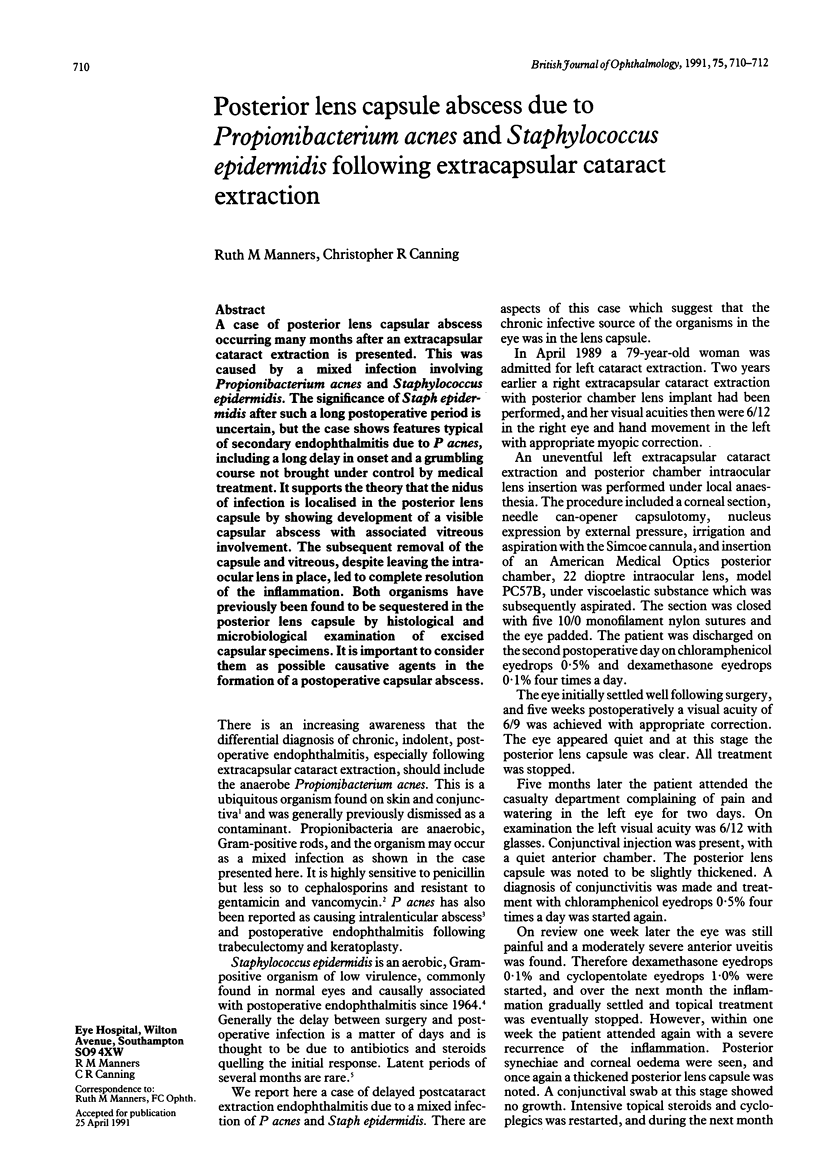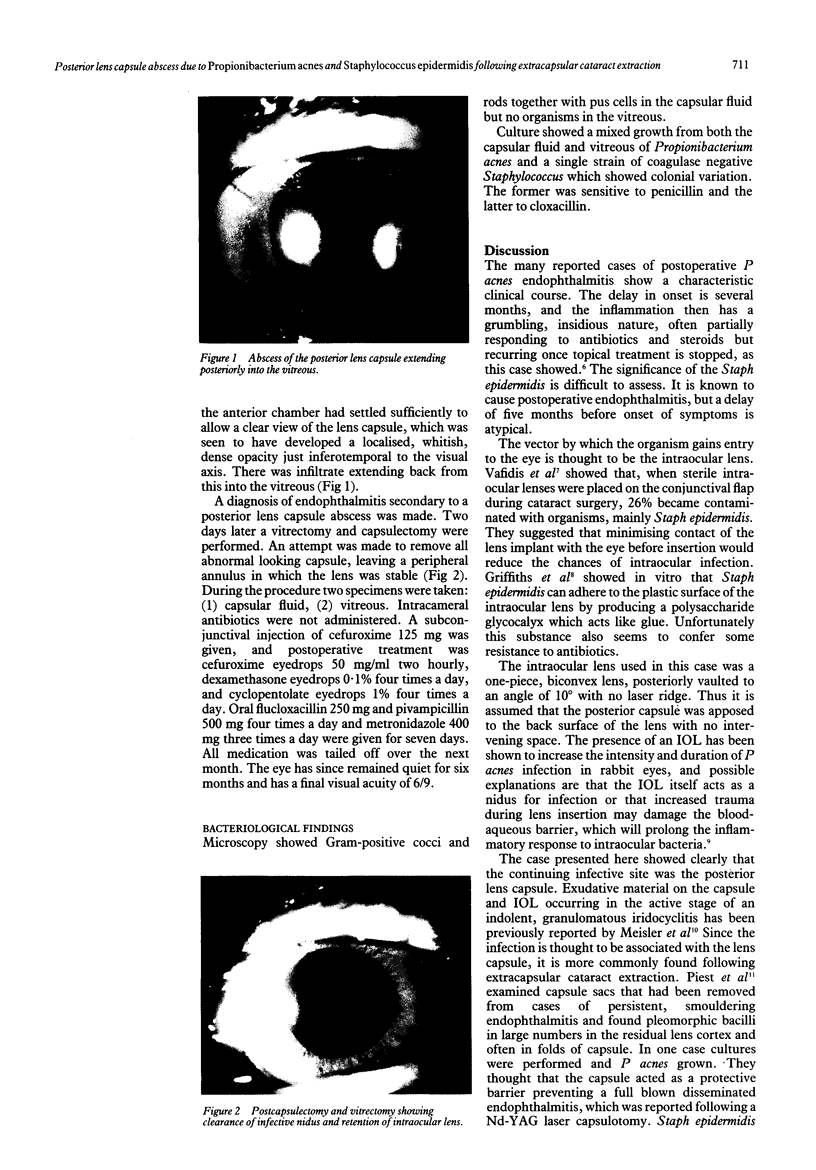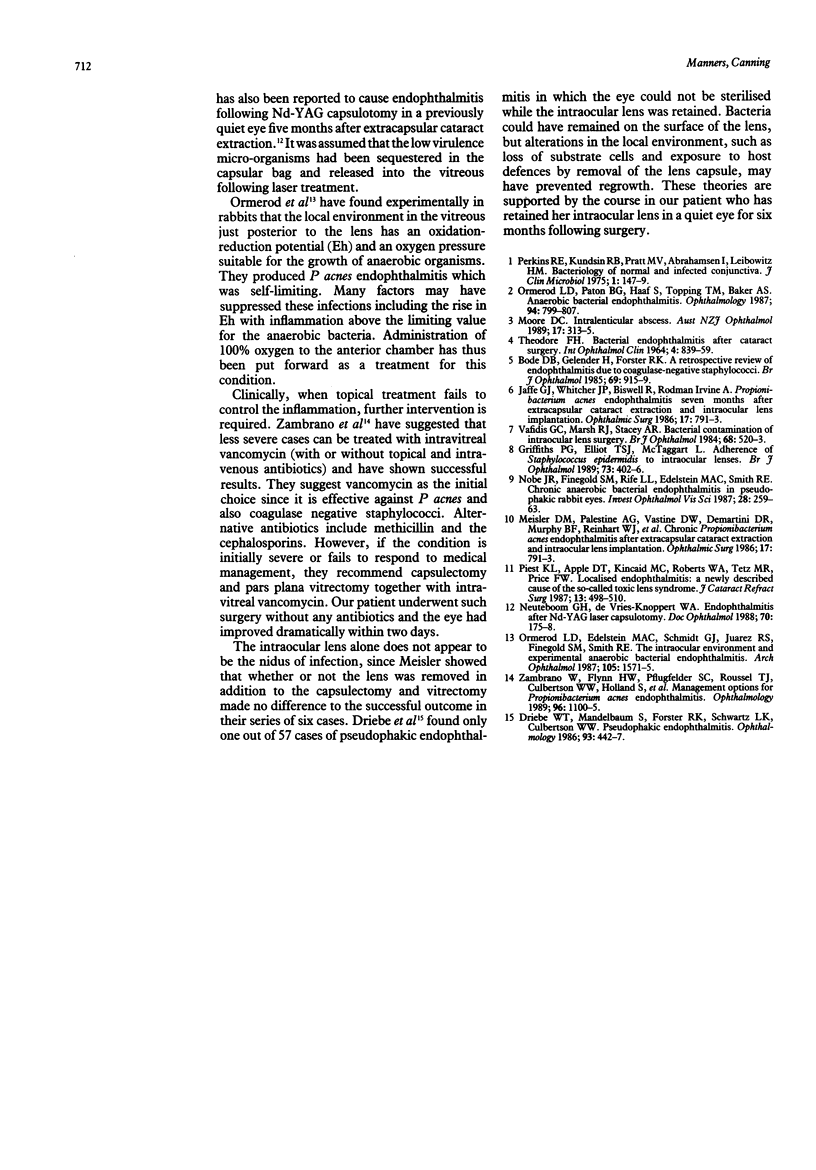Abstract
A case of posterior lens capsular abscess occurring many months after an extracapsular cataract extraction is presented. This was caused by a mixed infection involving Propionibacterium acnes and Staphylococcus epidermidis. The significance of Staph epidermidis after such a long postoperative period is uncertain, but the case shows features typical of secondary endophthalmitis due to P acnes, including a long delay in onset and a grumbling course not brought under control by medical treatment. It supports the theory that the nidus of infection is localised in the posterior lens capsule by showing development of a visible capsular abscess with associated vitreous involvement. The subsequent removal of the capsule and vitreous, despite leaving the intraocular lens in place, led to complete resolution of the inflammation. Both organisms have previously been found to be sequestered in the posterior lens capsule by histological and microbiological examination of excised capsular specimens. It is important to consider them as possible causative agents in the formation of a postoperative capsular abscess.
Full text
PDF


Images in this article
Selected References
These references are in PubMed. This may not be the complete list of references from this article.
- Bodé D. D., Jr, Gelender H., Forster R. K. A retrospective review of endophthalmitis due to coagulase-negative staphylococci. Br J Ophthalmol. 1985 Dec;69(12):915–919. doi: 10.1136/bjo.69.12.915. [DOI] [PMC free article] [PubMed] [Google Scholar]
- Driebe W. T., Jr, Mandelbaum S., Forster R. K., Schwartz L. K., Culbertson W. W. Pseudophakic endophthalmitis. Diagnosis and management. Ophthalmology. 1986 Apr;93(4):442–448. doi: 10.1016/s0161-6420(86)33722-9. [DOI] [PubMed] [Google Scholar]
- Griffiths P. G., Elliot T. S., McTaggart L. Adherence of Staphylococcus epidermidis to intraocular lenses. Br J Ophthalmol. 1989 Jun;73(6):402–406. doi: 10.1136/bjo.73.6.402. [DOI] [PMC free article] [PubMed] [Google Scholar]
- Jaffe G. J., Whitcher J. P., Biswell R., Irvine A. R. Propionibacterium acnes endophthalmitis seven months after extracapsular cataract extraction and intraocular lens implantation. Ophthalmic Surg. 1986 Dec;17(12):791–793. [PubMed] [Google Scholar]
- Jaffe G. J., Whitcher J. P., Biswell R., Irvine A. R. Propionibacterium acnes endophthalmitis seven months after extracapsular cataract extraction and intraocular lens implantation. Ophthalmic Surg. 1986 Dec;17(12):791–793. [PubMed] [Google Scholar]
- Moore D. C. Intralenticular abscess. Aust N Z J Ophthalmol. 1989 Aug;17(3):313–315. doi: 10.1111/j.1442-9071.1989.tb00540.x. [DOI] [PubMed] [Google Scholar]
- Neuteboom G. H., de Vries-Knoppert W. A. Endophthalmitis after Nd:YAG laser capsulotomy. Doc Ophthalmol. 1988 Oct-Nov;70(2-3):175–178. doi: 10.1007/BF00154450. [DOI] [PubMed] [Google Scholar]
- Nobe J. R., Finegold S. M., Rife L. L., Edelstein M. A., Smith R. E. Chronic anaerobic bacterial endophthalmitis in pseudophakic rabbit eyes. Invest Ophthalmol Vis Sci. 1987 Feb;28(2):259–263. [PubMed] [Google Scholar]
- Ormerod L. D., Edelstein M. A., Schmidt G. J., Juarez R. S., Finegold S. M., Smith R. E. The intraocular environment and experimental anaerobic bacterial endophthalmitis. Arch Ophthalmol. 1987 Nov;105(11):1571–1575. doi: 10.1001/archopht.1987.01060110117044. [DOI] [PubMed] [Google Scholar]
- Ormerod L. D., Paton B. G., Haaf J., Topping T. M., Baker A. S. Anaerobic bacterial endophthalmitis. Ophthalmology. 1987 Jul;94(7):799–808. doi: 10.1016/s0161-6420(87)33532-8. [DOI] [PubMed] [Google Scholar]
- Perkins R. E., Kundsin R. B., Pratt M. V., Abrahamsen I., Leibowitz H. M. Bacteriology of normal and infected conjunctiva. J Clin Microbiol. 1975 Feb;1(2):147–149. doi: 10.1128/jcm.1.2.147-149.1975. [DOI] [PMC free article] [PubMed] [Google Scholar]
- Piest K. L., Kincaid M. C., Tetz M. R., Apple D. J., Roberts W. A., Price F. W., Jr Localized endophthalmitis: a newly described cause of the so-called toxic lens syndrome. J Cataract Refract Surg. 1987 Sep;13(5):498–510. doi: 10.1016/s0886-3350(87)80103-7. [DOI] [PubMed] [Google Scholar]
- THEODORE F. H. BACTERIAL ENDOPHTHALMITIS AFTER CATARACT SURGERY. Int Ophthalmol Clin. 1964 Dec;4:839–859. doi: 10.1097/00004397-196412000-00005. [DOI] [PubMed] [Google Scholar]
- Vafidis G. C., Marsh R. J., Stacey A. R. Bacterial contamination of intraocular lens surgery. Br J Ophthalmol. 1984 Aug;68(8):520–523. doi: 10.1136/bjo.68.8.520. [DOI] [PMC free article] [PubMed] [Google Scholar]
- Zambrano W., Flynn H. W., Jr, Pflugfelder S. C., Roussel T. J., Culbertson W. W., Holland S., Miller D. Management options for Propionibacterium acnes endophthalmitis. Ophthalmology. 1989 Jul;96(7):1100–1105. doi: 10.1016/s0161-6420(89)32768-0. [DOI] [PubMed] [Google Scholar]




